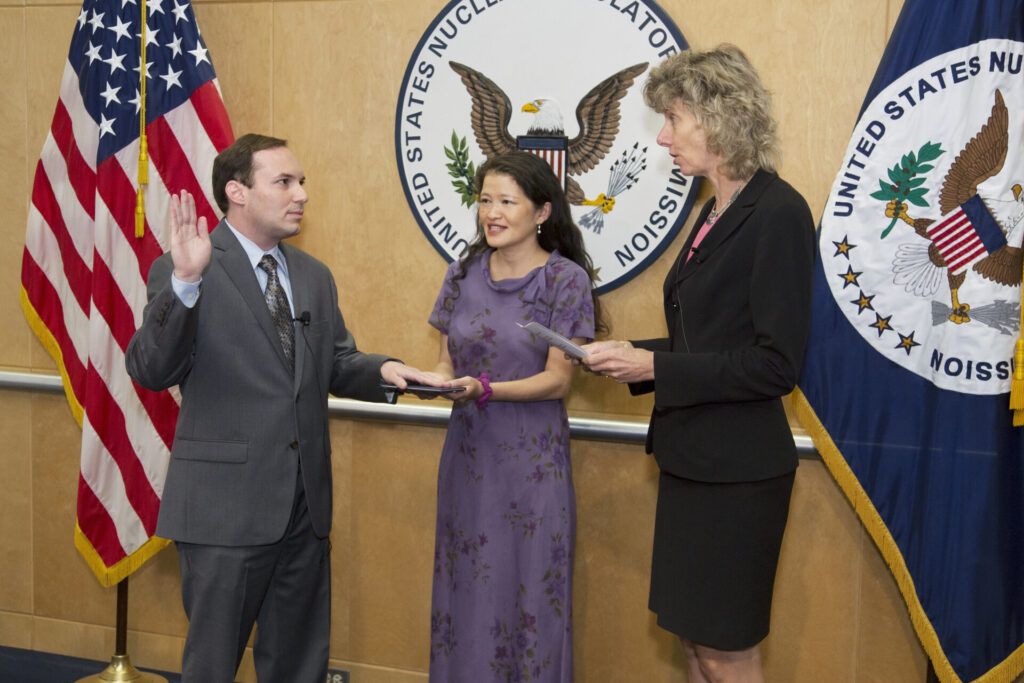Congress torpedoes a Biden nominee and casts doubt on nuclear safety
By Allison Macfarlane | February 6, 2024
 Jeff Baran was first nominated by President Obama and sworn in as a Commissioner of the US Nuclear Regulatory Commission on October 14, 2014. In January, President Joe Biden dropped Baran's nomination for a third term after a handful of Democrats joined Senate Republicans to block the nomination last year. (Credit: US NRC, via Flickr)
Jeff Baran was first nominated by President Obama and sworn in as a Commissioner of the US Nuclear Regulatory Commission on October 14, 2014. In January, President Joe Biden dropped Baran's nomination for a third term after a handful of Democrats joined Senate Republicans to block the nomination last year. (Credit: US NRC, via Flickr)
The Biden administration’s recent abandonment of Jeff Baran for another term as member on the US Nuclear Regulatory Commission (NRC) bodes ill for the independence of the agency—and the safety and security of the country. A longtime commissioner, Baran reportedly did not have enough support from some senate Democrats to win another nomination.
His crimes? Being “an overzealous regulator overtly hostile to nuclear energy.”
Senate Democrats say they would prefer a nominee who is not “too focused on safety.” But the NRC is not a pro- or an anti-nuclear group; it’s an independent regulator, whose mission is to protect public health and safety, ensure security, and protect the environment.
Baran’s opponents in the Senate and in public interest groups cited his track record of being the lone NRC commissioner (of five) to consistently vote in favor of more environmental protection and safety. But with the other four votes typically going in the opposite direction, the decisions favored by the nuclear industry often won out. Baran was hardly a threat to the industry. Does the nuclear industry and its supporters really want the NRC to become an echo chamber instead of a balanced and trusted regulator?
The real value of a regulatory agency lies in its independence. And that means that it should remain free of industry and political influence. Of course, a successful regulator also must have adequate personnel and financial support, as well as backing by the government, so it can do its job, and sufficient power that, if it needs to, it can shut down an unsafe facility. The importance of an independent nuclear regulator cannot be overemphasized because if there was a nuclear accident due to lax regulation, not only would the industry be put at risk, but the entire economy might be as well.
Take, for example, the accident at the Fukushima Daiichi nuclear plant in Japan on March 11, 2011. At the time of the disaster, Japan operated 54 nuclear power reactors, making up 30 percent of the country’s electricity supply. Within a year after the accident, all were shut down, awaiting regulatory review. Such a massive loss of electricity supply directly impacted the economy of the country—not to mention the 160,000 people who evacuated the area near the crippled plant and the loss of agriculture, fishing, and public trust of the industry. In fact, all nuclear plants around the world were impacted by this accident; in the United States, the nuclear industry spent billions of dollars making safety improvements as a result.
The Japanese Diet reviewed the reasons for the accident and stated clearly that it was a disaster “Made in Japan.” The report noted that the Japanese regulator at the time was overseen by the same government agency responsible for promoting nuclear power, and that “collusion between the government, the regulators and TEPCO [the plant operator and owner]” was responsible for the accident. Clearly, when the regulator is not independent, but subject to industry and political pressure, disaster may follow. Now, 13 years after the accident, only 11 reactors are operating in Japan. Though the government hopes to increase this number, Japan’s nuclear industry has been forever changed for the worse.
Many in the nuclear industry are hoping to herald a yearned-for renaissance through the commercialization of small modular and advanced reactors. In the United States, none of these reactor designs has ever been constructed, let alone actually demonstrated. That has not stopped the industry and its promoters from claiming that small modular reactors (SMRs) are safer and cheaper than existing large light water reactors—though because they have not been demonstrated, let alone achieved commercial success, the actual costs and safety issues are unknown. For nuclear power supporters, what is holding the industry back from making a dent in fossil fuel usage is the NRC.
Nothing could be further from the truth.
For years, the NRC has worked proactively with the nascent SMR industry, providing guidance as to how to follow the design certification and licensing processes. And recall that Congress structured the NRC as a fee-for-service agency that must recover 90 percent of its budget from fees paid by licensees by law. This means the agency doesn’t get paid until an application is submitted, but regulators have already done a lot of work even before anyone has submitted a license application. And even then, the fees from the agency are a tiny fraction of what it costs to bring a reactor to commercialization. For instance, in the NRC’s Design Certification process, the agency’s fees amount to between 2.5 and 7.5 percent of the total costs of the reactor.
But blaming the NRC for the industry’s woes is a red herring that deflects the real challenges and uncertainties of developing a new technology onto the regulator. Even if the NRC stopped charging fees and gave all license applications a pass on rigorous safety requirements, the SMR industry would still struggle to commercialize its products. That is because the real issue with these reactors is their economics: SMRs are expensive technologies, especially compared to the cheap cost of wind, solar, and natural gas. And costs for renewables keep decreasing every year.
Why therefore are the costs of new nuclear reactors so high if the licensing process isn’t to blame? In any engineering endeavor, a design is first sketched that then must be built as a scale model. In doing so, the original design will change as new discoveries are made during construction and operation of the scale model. And this process of design improvements will continue even as the reactor is built at full scale or in commercial mode. In the nuclear industry, this process takes time because reactor construction takes time, and costs are high for this demonstration phase of the work. Costs and delays will be even higher for those designs that use novel fuels and non-light-water coolants and moderators. There is simply less operating experience and no supply chains established to build such reactors. According to the National Academies, bringing a new reactor technology to commercialization in the United States costs in the tens to hundreds of billions of dollars and takes multiple decades. Unfortunately, there is no way to fast-track this process, unless one wants to be assured of accidents and low reliability.
Like other federal independent regulators, the NRC has a staff led by five Senate-confirmed commissioners (two of whom are nominated by each political party and the fifth usually from the party of the president). To be functional, the NRC must have commissioners who have some technical understanding of nuclear facilities they are supposed to regulate. In the past, commissioners have been drawn from the Navy, academia, and other government agencies.
Over the last 20 years, however, the trend has been to tap congressional staffers—who are by definition political and clearly embody a means for members of Congress to interfere with NRC decision-making—to be commissioners. Such a practice has introduced politics directly into agency processes. The agency performs best, however, when it makes reasonably objective decisions based on expert knowledge of a complex technology. The United States should consider itself lucky compared to other nuclear operating nations because it has a diverse pool of nuclear experts to draw from to sit on the regulatory commission. Sadly, the increasing politicization of the NRC’s Senate confirmation process prevents the agency from benefitting from those experts, which undermines the safety of US nuclear facilities.
The nuclear industry has had its ups and downs with regards to public acceptance and support. For the US nuclear industry to continue to operate and grow, it is essential that it secures the public’s trust in that it will operate all installations safely and securely. Part of that support is grounded in the knowledge that the nuclear regulator has the best interests of the public—not those of the industry—in mind, as it does its job. It’s in the industry’s best interests to have an independent regulator. As many in the industry say, “an accident anywhere is an accident everywhere.”
Together, we make the world safer.
The Bulletin elevates expert voices above the noise. But as an independent nonprofit organization, our operations depend on the support of readers like you. Help us continue to deliver quality journalism that holds leaders accountable. Your support of our work at any level is important. In return, we promise our coverage will be understandable, influential, vigilant, solution-oriented, and fair-minded. Together we can make a difference.
Keywords: Congress, NRC, Nuclear Regulatory Commission, nuclear safety, small modular reactors
Topics: Nuclear Energy















Dr. Macfarlane’s rewording of the NRC’s mission could lead to some misunderstanding. Fortunately the complete mission statement is brief enough that it can be quoted in its entirety so that the carefully chosen words can become the basis for discussion. “The NRC licenses and regulates the Nation’s civilian use of radioactive materials to provide reasonable assurance of adequate protection of public health and safety and to promote the common defense and security and to protect the environment.” The NRC is not solely focused on safety, Neither is it tasked with achieving the impossible goal of perfect safety. The first PART… Read more »
I agree with you. I am a retired New Reactor design Senior (and Lead) Project Manager. As the lead PM, I tracked all of the review, including ACRS reviews, all budgetary actions, and all communications outside of the NRC regarding the review. I lead reviews of the (withdrawn) MHI and (DC issued) KHNP LLWRs and assisted in the review of the (DC issued) NuScale SMR. I also finalized the 20-yr renewal of the GE ABWR design. In particular, I agree that the increasingly political appointees to the Commission are hampering the staff in performing their mission and otherwise ruining the… Read more »